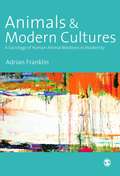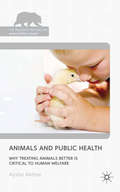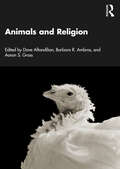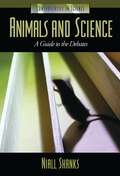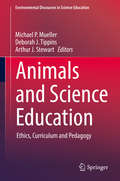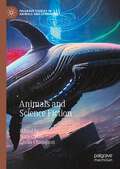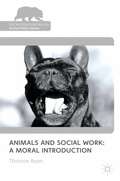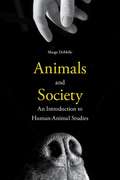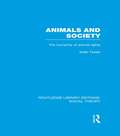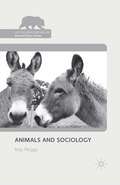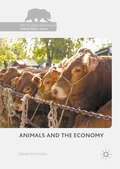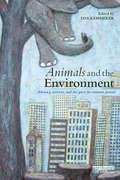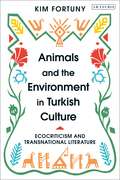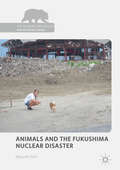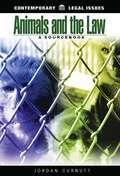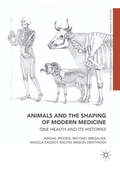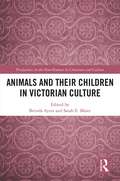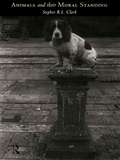- Table View
- List View
Animals and Modern Cultures
by Adrian FranklinThe dramatic transformation of relationships between humans and animals in the 20th century are investigated in this fascinating and accessible book. At the beginning of this century these relationships were dominated by human needs and interests, modernization was a project which was attached to the goal of progress and animals were merely resources to be used on the path towards human fulfilment. These relationships are increasingly being subjected to criticism and a new field of interest in human-animal relationships has opened up. We are now urged to be more sensitive and compassionate to animal needs and interests, to understand their mindedness and how their lives and ours are entangled. This book focuses on social change and animals, it is concerned with how humans relate to animals and how this has changed and why. Moreover, it highlights, through chapters on companion animals, hunting and fishing, animal leisures such as birdwatching and wildlife parks, and the meat and livestock industries, how attitudes and practices towards animals vary widely according to social class, ethnicity, gender, region and nation.
Animals and Modern Cultures: A Sociology of Human-Animal Relations in Modernity (PDF)
by Adrian FranklinThe dramatic transformation of relationships between humans and animals in the 20th century are investigated in this fascinating and accessible book. At the beginning of this century these relationships were dominated by human needs and interests, modernization was a project which was attached to the goal of progress and animals were merely resources to be used on the path towards human fulfilment. These relationships are increasingly being subjected to criticism and a new field of interest in human-animal relationships has opened up. We are now urged to be more sensitive and compassionate to animal needs and interests, to understand their mindedness and how their lives and ours are entangled. This book focuses on social change and animals, it is concerned with how humans relate to animals and how this has changed and why. Moreover, it highlights, through chapters on companion animals, hunting and fishing, animal leisures such as birdwatching and wildlife parks, and the meat and livestock industries, how attitudes and practices towards animals vary widely according to social class, ethnicity, gender, region and nation.
Animals and Public Health: Why Treating Animals Better is Critical to Human Welfare (The Palgrave Macmillan Animal Ethics Series)
by A. AkhtarA compelling argument of how human health is adversely affected by our poor treatment of non-human animals. The author contents that in order to successfully confront the 21st Century's health challenges, we need to broaden the definition of the word 'public' in public health to include non-human animals.
Animals and Religion
by Dave Aftandilian Barbara R. Ambros Aaron S. GrossWhat do animals—other than human animals—have to do with religion? How do our religious ideas about animals affect the lives of real animals in the world? How can we deepen our understanding of both animals and religion by considering them together? Animals and Religion explores how animals have crucially shaped how we understand ourselves, the other living beings around us, and our relationships with them.Through incisive analyses of religious examples from around the world, the original contributions to this volume demonstrate how animals have played key roles in every known religious tradition, whether as sacred beings, symbols, objects of concern, fellow creatures, or religious teachers. And through our religious imagination, ethics, and practices, we have deeply impacted animal lives, whether by domesticating, sacrificing, dominating, eating, refraining from eating, blessing, rescuing, releasing, commemorating, or contemplating them. Drawing primarily on perspectives from religious studies and Christian theology, augmented by cutting-edge work in anthropology, biology, philosophy, and psychology, Animals and Religion offers the reader a richer understanding of who animals are and who we humans are. Do animals have emotions? Do they think or use language? Are they persons? How we answer questions like these affects diverse aspects of religion that shape not only how we relate to other animals, but also how we perceive and misperceive each other along axes of gender, race, and (dis)ability.Accessibly written and thoughtfully argued, Animals and Religion will interest anyone who wants to learn more about animals, religion, and what it means to be a human animal.
Animals and Religion
What do animals—other than human animals—have to do with religion? How do our religious ideas about animals affect the lives of real animals in the world? How can we deepen our understanding of both animals and religion by considering them together? Animals and Religion explores how animals have crucially shaped how we understand ourselves, the other living beings around us, and our relationships with them.Through incisive analyses of religious examples from around the world, the original contributions to this volume demonstrate how animals have played key roles in every known religious tradition, whether as sacred beings, symbols, objects of concern, fellow creatures, or religious teachers. And through our religious imagination, ethics, and practices, we have deeply impacted animal lives, whether by domesticating, sacrificing, dominating, eating, refraining from eating, blessing, rescuing, releasing, commemorating, or contemplating them. Drawing primarily on perspectives from religious studies and Christian theology, augmented by cutting-edge work in anthropology, biology, philosophy, and psychology, Animals and Religion offers the reader a richer understanding of who animals are and who we humans are. Do animals have emotions? Do they think or use language? Are they persons? How we answer questions like these affects diverse aspects of religion that shape not only how we relate to other animals, but also how we perceive and misperceive each other along axes of gender, race, and (dis)ability.Accessibly written and thoughtfully argued, Animals and Religion will interest anyone who wants to learn more about animals, religion, and what it means to be a human animal.
Animals and Science: A Guide to the Debates (Controversies in Science)
by Niall ShanksAnimals and Science examines the debates, from the Renaissance to the present, surrounding issues of animal rights, consciousness, and self-awareness.Animals and Science examines what science has (and has not) taught us about the nature of nonhuman animals and explores the moral, religious, social, and scientific implications of those teachings. It shows how the scientific study of animals, especially their cognitive abilities, has transformed our understanding of them. Animals and Science traces our evolving understanding of animal pain and considers its moral relevance to humans. It discusses Darwin's belief-shattering notion that species differences are not absolute, then traces its impact to the present day.Ultimately, Animals and Science is about the nature of science—the kinds of questions science can and cannot answer, and the role of theory in shaping the interpretation of evidence.
Animals and Science Education: Ethics, Curriculum and Pedagogy (Environmental Discourses in Science Education #2)
by Michael P. Mueller Deborah J. Tippins Arthur J. StewartThis book discusses how we can inspire today’s youth to engage in challenging and productive discussions around the past, present and future role of animals in science education. Animals play a large role in the sciences and science education and yet they remain one of the least visible topics in the educational literature. This book is intended to cultivate research topics, conversations, and dispositions for the ethical use of animals in science and education. This book explores the vital role of animals with/in science education, specimens, protected species, and other associated issues with regards to the role of animals in science. Topics explored include ethical, curriculum and pedagogical dimensions, involving invertebrates, engineering solutions that contribute to ecosystems, the experiences of animals under our care, aesthetic and contemplative practices alongside science, school-based ethical dialogue, nature study for promoting inquiry and sustainability, the challenge of whether animals need to be used for science whatsoever, reconceptualizing museum specimens, cultivating socioscientific issues and epistemic practice, cultural integrity and citizen science, the care and nurturance of gender-balanced curriculum choices for science education, and theoretical conversations around cultivating critical thinking skills and ethical dispositions. The diverse authors in this book take on the logic of domination and symbolic violence embodied within the scientific enterprise that has systematically subjugated animals and nature, and emboldened the anthropocentric and exploitative expressions for the future role of animals.At a time when animals are getting excluded from classrooms (too dangerous! too many allergies! too dirty!), this book is an important counterpoint. Interacting with animals helps students develop empathy, learn to care for living things, engage with content. We need more animals in the science curriculum, not less.David Sobel, Senior Faculty, Education Department, Antioch University New England
Animals and Science Fiction (Palgrave Studies In Animals And Literature Ser.)
by Nora Castle Giulia ChampionAnimals and Social Work: A Moral Introduction (The Palgrave Macmillan Animal Ethics Series)
by T. RyanSocial Work and Animals represents a pioneering contribution to the literature of social work ethics and moral philosophy. It advances cogent and detailed arguments for the inclusion of animals within social work's moral framework, arguments that have profound theoretical and practical implications for the discipline and its practitioners.
Animals And Society: An Introduction To Human-animal Studies (PDF)
by Margo DeMelloConsidering that much of human society is structured through its interaction with non-human animals, and since human society relies heavily on the exploitation of animals to serve human needs, human-animal studies has become a rapidly expanding field of research, featuring a number of distinct positions, perspectives, and theories that require nuanced explanation and contextualization. The first book to provide a full overview of human-animal studies, this volume focuses on the conceptual construction of animals in American culture and the way in which it reinforces and perpetuates hierarchical human relationships rooted in racism, sexism, and class privilege. Margo DeMello considers interactions between humans and animals within the family, the law, the religious and political system, and other major social institutions, and she unpacks the different identities humans fashion for themselves and for others through animals. Essays also cover speciesism and evolutionary continuities; the role and preservation of animals in the wild; the debate over zoos and the use of animals in sports; domestication; agricultural practices such as factory farming; vivisection; animal cruelty; animal activism; the representation of animals in literature and film; and animal ethics. Sidebars highlight contemporary controversies and issues, with recommendations for additional reading, educational films, and related websites. DeMello concludes with an analysis of major philosophical positions on human social policy and the future of human-animal relations.
Animals and Society: The Humanity of Animal Rights (Routledge Library Editions: Social Theory)
by Keith TesterAnimals and Society uses a variety of historical sources and a coherent social theory to tell the story of the invention of animal rights. It moves from incidents like the medieval execution of pigs to a discussion of the politics and strategies of modern rights organisations. The book also presents radical interpretations of nineteenth-century animal welfare laws, and the accounts of the Noble Savage. The insights generated by social science are always at the core of the discussion and the author daws on the work of Michel Foucault, Norbert Elias, Claude Levi-Strauss and Mary Douglas. This wide-ranging and accessible book provides a fascinating account of the relations between humans and animals. It raises far-reaching questions about the philosophy, history and politics of animal rights.
Animals and Society: The Humanity of Animal Rights (Routledge Library Editions: Social Theory)
by Keith TesterAnimals and Society uses a variety of historical sources and a coherent social theory to tell the story of the invention of animal rights. It moves from incidents like the medieval execution of pigs to a discussion of the politics and strategies of modern rights organisations. The book also presents radical interpretations of nineteenth-century animal welfare laws, and the accounts of the Noble Savage. The insights generated by social science are always at the core of the discussion and the author daws on the work of Michel Foucault, Norbert Elias, Claude Levi-Strauss and Mary Douglas. This wide-ranging and accessible book provides a fascinating account of the relations between humans and animals. It raises far-reaching questions about the philosophy, history and politics of animal rights.
Animals and Sociology (The Palgrave Macmillan Animal Ethics Series)
by K. PeggsAnimals and Sociology challenges traditional assumptions about the nature of sociology. Sociology often centres on humans; however, other animals are everywhere in society. Kay Peggs explores the significant contribution that sociology can make to our understanding of human relations with other animals.
Animals and the Economy (The Palgrave Macmillan Animal Ethics Series)
by Steven McMullenThis book explores the economic institutions that determine the nature of animal lives as systematically exploited objects traded in a market economy. It examines human roles and choice in the system, including the economic logic of agriculture, experimentation, and animal ownership, and analyses the marginalization of ethical action in the economic system. Animals and the Economy demonstrates that individual consumers and farmers are often left with few truly animal-friendly choices. Ethical participants in the economy must either face down an array of institutional barriers, or exit mainstream markets entirely. This book argues that these issues are not necessary elements of a market system, and evaluates a number of policy changes that could improve the lives of animals in the context of a market economy.
Animals and the Environment: Advocacy, activism, and the quest for common ground
by Lisa KemmererContemporary Earth and animal activists rarely collaborate, perhaps because environmentalists focus on species and ecosystems, while animal advocates look to the individual, and neither seems to have much respect for the other. This diverse collection of essays highlights common ground between earth and animal advocates, most notably the protection of wildlife and personal dietary choice. If earth and animal advocates move beyond philosophical differences and resultant divergent priorities, turning attention to shared goals, both will be more effective – and both animals and the environment will benefit. Given the undeniable seriousness of the environmental problems that we face, including climate change and species extinction, it is essential that activists join forces. Drawing on a wide range of issues and disciplines, ranging from wildlife management, hunting, and the work of NGOs to ethics, ecofeminism, religion and animal welfare, this volume provides a stimulating collection of ideas and challenges for anyone else who cares about the environment or animals.
Animals and the Environment: Advocacy, activism, and the quest for common ground
by Lisa KemmererContemporary Earth and animal activists rarely collaborate, perhaps because environmentalists focus on species and ecosystems, while animal advocates look to the individual, and neither seems to have much respect for the other. This diverse collection of essays highlights common ground between earth and animal advocates, most notably the protection of wildlife and personal dietary choice. If earth and animal advocates move beyond philosophical differences and resultant divergent priorities, turning attention to shared goals, both will be more effective – and both animals and the environment will benefit. Given the undeniable seriousness of the environmental problems that we face, including climate change and species extinction, it is essential that activists join forces. Drawing on a wide range of issues and disciplines, ranging from wildlife management, hunting, and the work of NGOs to ethics, ecofeminism, religion and animal welfare, this volume provides a stimulating collection of ideas and challenges for anyone else who cares about the environment or animals.
Animals and the Environment in Turkish Culture: Ecocriticism and Transnational Literature
by Kim FortunyLandscape and animals have been fundamental elements of Turkish culture from the Ottomans to the present day. This book examines representations of and attitudes toward land and animals in selected Turkish literary texts and cultural contexts. Informed by global debates in ecocriticism, ecopoetics and animal studies, Kim Fortuny explores literary and arts activism, as well as environmental interventions in the Turkish cultural sphere in light of ongoing ecological degradation in Turkey. Writers from the Turkish canon such as Ahmet Hamdi Tanpinar and Nâzim Hikmet are explored alongside American and English texts to reveal common transnational environmental and ecological concerns across these distinct literary cultures. Analysing works of Turkish literature within the emerging field of ecocriticism, this interdisciplinary work will be of interest to scholars of Turkish and comparative literature and animal studies and ecocriticism across the humanities.
Animals and the Environment in Turkish Culture: Ecocriticism and Transnational Literature
by Kim FortunyLandscape and animals have been fundamental elements of Turkish culture from the Ottomans to the present day. This book examines representations of and attitudes toward land and animals in selected Turkish literary texts and cultural contexts. Informed by global debates in ecocriticism, ecopoetics and animal studies, Kim Fortuny explores literary and arts activism, as well as environmental interventions in the Turkish cultural sphere in light of ongoing ecological degradation in Turkey. Writers from the Turkish canon such as Ahmet Hamdi Tanpinar and Nâzim Hikmet are explored alongside American and English texts to reveal common transnational environmental and ecological concerns across these distinct literary cultures. Analysing works of Turkish literature within the emerging field of ecocriticism, this interdisciplinary work will be of interest to scholars of Turkish and comparative literature and animal studies and ecocriticism across the humanities.
Animals and the Fukushima Nuclear Disaster (The Palgrave Macmillan Animal Ethics Series)
by Mayumi ItohThis book is the first comprehensive, in-depth English language study of the animals that were left behind in the exclusion zone in the wake of the nuclear meltdown of three of the four reactors at the Fukushima Daiichi Nuclear Power Station in March 2011, triggered by the Great East Japan Earthquake of magnitude 9.0.The Japanese government designated an area of 20-kilometer radius from the nuclear power station as an exclusion zone and evacuated one hundred thousand residents, but left companion animals and livestock animals behind in the radioactive area. Consequently, about 90 percent of the animals in the exclusion zone died. This book juxtaposes policies of the Japanese government toward the animals in Fukushima with the actions of grassroots volunteer animal rescue groups that filled the void of the government.
Animals and the Law: A Sourcebook (Contemporary Legal Issues)
by Jordan CurnuttOffers a comprehensive overview of the legislation and legal issues surrounding animals.Written by Jordan Curnutt, Animals and the Law covers everything from the Silver Spring monkeys, subjects in the first U.S. lab raided by police where criminal charges were filed against a scientist conducting federally funded research, to sex with animals. Among the subjects reviewed are kosher and Halal food restrictions, mad cow disease and cattle cannibalism, animals in laboratories, and as entertainment—in circuses, zoos, rodeos, horse racing, cockfighting, and more. Also included are appendixes of animal organizations, cases, statutes and regulations, and an extensive bibliography.
Animals and the Shaping of Modern Medicine: One Health and its Histories
by Angela Cassidy Abigail Woods Michael Bresalier Rachel Mason DentingerThis book is open access under a CC BY 4.0 license.This book breaks new ground by situating animals and their diseases at the very heart of modern medicine. In demonstrating their historical significance as subjects and shapers of medicine, it offers important insights into past animal lives, and reveals that what we think of as ‘human’ medicine was in fact deeply zoological.Each chapter analyses an important episode in which animals changed and were changed by medicine. Ranging across the animal inhabitants of Britain’s zoos, sick sheep on Scottish farms, unproductive livestock in developing countries, and the tapeworms of California and Beirut, they illuminate the multi-species dimensions of modern medicine and its rich historical connections with biology, zoology, agriculture and veterinary medicine. The modern movement for One Health – whose history is also analyzed – is therefore revealed as just the latest attempt to improve health by working across species and disciplines. This book will appeal to historians of animals, science and medicine, to those involved in the promotion and practice of One Health today.
Animals and the Shaping of Modern Medicine: One Health and its Histories
by Abigail Woods Michael Bresalier Angela Cassidy Rachel Mason DentingerThis book is open access under a CC BY 4.0 license.This book breaks new ground by situating animals and their diseases at the very heart of modern medicine. In demonstrating their historical significance as subjects and shapers of medicine, it offers important insights into past animal lives, and reveals that what we think of as ‘human’ medicine was in fact deeply zoological.Each chapter analyses an important episode in which animals changed and were changed by medicine. Ranging across the animal inhabitants of Britain’s zoos, sick sheep on Scottish farms, unproductive livestock in developing countries, and the tapeworms of California and Beirut, they illuminate the multi-species dimensions of modern medicine and its rich historical connections with biology, zoology, agriculture and veterinary medicine. The modern movement for One Health – whose history is also analyzed – is therefore revealed as just the latest attempt to improve health by working across species and disciplines. This book will appeal to historians of animals, science and medicine, to those involved in the promotion and practice of One Health today.
Animals and Their Children in Victorian Culture (Perspectives on the Non-Human in Literature and Culture)
by Brenda Ayres Sarah Elizabeth MaierWhether a secularized morality, biblical worldview, or unstated set of mores, the Victorian period can and always will be distinguished from those before and after for its pervasive sense of the "proper way" of thinking, speaking, doing, and acting. Animals in literature taught Victorian children how to be behave. If you are a postmodern posthumanist, you might argue, "But the animals in literature did not write their own accounts." Animal characters may be the creations of writers’ imagination, but animals did and do exist in their own right, as did and do humans. The original essays in Animals and Their Children in Victorian explore the representation of animals in children’s literature by resisting an anthropomorphized perception of them. Instead of focusing on the domestication of animals, this book analyzes how animals in literature "civilize" children, teaching them how to get along with fellow creatures—both human and nonhuman.
Animals and Their Children in Victorian Culture (Perspectives on the Non-Human in Literature and Culture)
by Brenda Ayres Sarah Elizabeth MaierWhether a secularized morality, biblical worldview, or unstated set of mores, the Victorian period can and always will be distinguished from those before and after for its pervasive sense of the "proper way" of thinking, speaking, doing, and acting. Animals in literature taught Victorian children how to be behave. If you are a postmodern posthumanist, you might argue, "But the animals in literature did not write their own accounts." Animal characters may be the creations of writers’ imagination, but animals did and do exist in their own right, as did and do humans. The original essays in Animals and Their Children in Victorian explore the representation of animals in children’s literature by resisting an anthropomorphized perception of them. Instead of focusing on the domestication of animals, this book analyzes how animals in literature "civilize" children, teaching them how to get along with fellow creatures—both human and nonhuman.
Animals and Their Moral Standing
by Stephen R Clark Stephen R. ClarkTwenty years ago, people thought only cranks or sentimentalists could be seriously concerned about the treatment of non-human animals. However, since then philosophers, scientists and welfarists have raised public awareness of the issue; and they have begun to lay the foundations for an enormous change in human practice. This book is a record of the development of 'animal rights' through the eyes of one highly-respected and well-known thinker. This book brings together for the first time Stephen R.L. Clark's major essays in one volume. Written with characteristic clarity and persuasion, Animals and Their Moral Standing will be essential reading for both philosophers and scientists, as well as the general reader concerned by the debates over animal rights and treatment.
